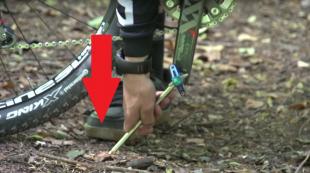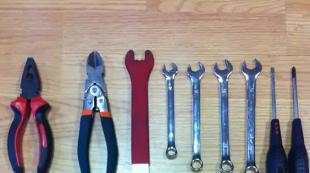Fine for driving a boat without a license. Features of the operation of inflatable boats. Sailing boat courses, rudder and sheet control
Before going on a boat trip or fishing, let's prepare ourselves mentally, technically and legally so that we can have fun and not a headache. An inflatable boat with a motor is a small craft (SV). In the spring of this year, an accurate and unified definition of MS will finally (!) be introduced and approved by the State Duma, but for now a vessel with two outboard motors of 300 hp each. - this is also a small boat! Also in the spring of 2012, changes will be made to the procedure for registering MS.
Ignorance of the rules of navigation does not exempt you from liability: administrative, criminal, and certainly will not save you from pangs of conscience because of the injured person.
. The administrative code is based on the principle of the presumption of innocence:
- a person is liable only for those offenses for which his guilt is indicated;
- a person held administratively liable is not required to prove his innocence;
- is considered innocent until his guilt is proven in the manner prescribed by the code.
. For violation of the rules of navigation we face the following types of administrative punishment:
- just a fine;
- “complex” punishment: a warning, a fine or deprivation of rights (abbr. PSL), which the inspector decides to apply to you.
. It is not the inspector who deprives you of your rights, but the judge.
. To analyze tragic cases, there are river and maritime prosecutors' offices.
. The only violation for which a boat is sent to a parking fine is operating the vessel in drunk. The vessel remains there until the cause of the violation is eliminated, that is, until you sober up, or the boat can be picked up by an authorized person (legally registered).
If there is no official parking lot on a body of water, then “there is no court.”
For example, in St. Petersburg there is such a parking fine: towing and the first day are free. In the case where the boat or motorboat does not exceed the length of 10 meters, the owner will need to pay 21 rubles per hour of parking (504 rubles per day). . There is still a chance to get a parking fine on suspicion of stealing a boat, i.e. you should always have documents for it or a ship's ticket.
. Driving a motor vehicle while intoxicated or transferring control to an equally drunk person, as well as to a person without a license: a fine of 1500-2000 rubles. or deprivation of rights for a period of 1 to 2 years.
. A license is needed for MS with an engine power greater than 3.68 kW (5 hp). If you have 3.7 kW, then you need it. A boat with a motor power of up to 3.68 kW can be operated by any crew member (sober).
. If all crew members have licenses, then you can replace each other at the wheel without any bureaucratic paperwork (powers of attorney), if the owner of the boat is on board. If a friend gave you a boat for a ride, then you need to draw up a power of attorney (can be handwritten).
The most common fines
Note: fines are cumulative, but any can be challenged in court.
Operating an unregistered vessel - a fine of 500 to 1000 rubles.
. Operating a vessel that has not passed technical inspection - a fine of 500 to 1000 rubles.
. Driving a vessel that does not carry side numbers - a fine of 500 to 1000 rubles.
. Driving a vessel in violation of the navigation area - a fine of 500 to 1000 rubles.
There are three types of sailing areas and St. Petersburg has them all.
MP (sea routes) - they can be recognized by sea buoys, for example, the Neva River behind the Blagoveshchensky Bridge and the Gulf of Finland.
IWW (inland waterways) - Neva, the river along which large cargo and passenger ships, as well as MS, sail.
VP (internal routes) - the Fontanka River, the Moika and all the canals of St. Petersburg, the Ivanovsky quarry at the station. Lomonosovskaya metro station, etc.
Navigation areas are indicated on the ship's ticket and the driver's license of a small boat (photo on the right) (not all areas may be indicated in both documents (!), depending on how you studied and what you plan to sail on).
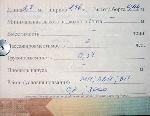 Let's study the ship's ticket. We open the page and see: VP, GDP, MP - these are the navigation areas. The wave height is 0.40 m, the distance from the shore is 3000 m. This means that when we go out into the Gulf of Finland (GP), we should not move further than 3 km from the shore (the nearest shelter). Simply put, in any of these areas you can drive a boat motor up to 3.68 kW without a license, and if the motor is more powerful, then with a license.
Let's study the ship's ticket. We open the page and see: VP, GDP, MP - these are the navigation areas. The wave height is 0.40 m, the distance from the shore is 3000 m. This means that when we go out into the Gulf of Finland (GP), we should not move further than 3 km from the shore (the nearest shelter). Simply put, in any of these areas you can drive a boat motor up to 3.68 kW without a license, and if the motor is more powerful, then with a license.
. Driving a converted vessel without permission (for example, installing a motor on a boat registered as a rowing boat) - a fine of 500 to 1000 rubles.
Here is the soulless face of a bureaucrat: you take the Pella on the base (according to the documents of the rental base, this is a rowing boat, although according to the passport it is motor-rowing and is designed to install a motor of up to 2.3 hp) and hang a 2 hp motor on the transom (there is a certificate of invoice) and you are to blame, although you don’t even have to pay taxes for engines up to 3.68 kW!
Violation of the rules for ensuring the safety of passengers on the MS (lack of a vest; there is a vest, but is not worn while moving; sitting on board a boat while moving, more passengers than allowed) - a fine of 300 - 500 rubles.
Let's read another page of the ship's ticket. These “mysterious” icons at the bottom of the photo on the right are the ship’s class formula: 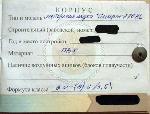 2 means motorboat
2 means motorboat
U - means ship without deck
- means there are no waterproof compartments
(4) - wave height class
2 - number of people on the vessel max
/3.6 - max engine power for this vessel in kW
So there are five of us in double boat there is no need to climb... and it won’t be possible to use a five instead of 4.0 hp (3.6 kW).
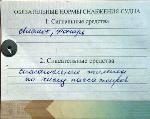 Let's look at other pages of the ship's ticket (photo on the left). The inspector wanted to give you a fire extinguisher, but at that moment he sneezed and forgot to do it... when meeting you at the pond, even he himself does not have the right to demand one. You should only have what is written in your boat.
Let's look at other pages of the ship's ticket (photo on the left). The inspector wanted to give you a fire extinguisher, but at that moment he sneezed and forgot to do it... when meeting you at the pond, even he himself does not have the right to demand one. You should only have what is written in your boat.
A ship's ticket is a legal document confirming your rights as an owner, and if someone bad steals your boat, on this basis you can put the boat on the wanted list. A ship's ticket is issued after registering the boat with GIMS (State Inspectorate for Small Boats).
. Exceeding the set speed, failure to comply with the requirements of navigation signs, stopping or parking in prohibited places, violation of the rules of maneuvering and giving sound signals- warning, fine from 300 to 500 rubles, deprivation of rights for 6 months.
Let's take a closer look at this point. There is no speed limit on the Neva and in the Gulf of Finland yet, but on all internal rivers and canals of St. Petersburg it is not higher than 8 km/h (when passing berths - 5 km/h).
Failure to comply with the requirements of navigation signs - the sign not to drop the anchor (the very first photo at the beginning of the article) will be understood by a beginner, and about the rest in the next article. Stopping or parking in prohibited places - under a bridge is not allowed, where large ships sail - I categorically do not advise (you will be safe), and you should not approach the nuclear power plant either.
Violation of the rules of maneuvering - movement on reservoirs is right-handed, that is, the right side of the boat should always be closer to the bank of the river (canal) than the left, the obstacle on the right is like on land, you must pass on the left sides (it is advisable to do the same on lakes). Giving way to a rowing boat (also MS) does not mean stopping; you need to carefully go around the rowing boat, without creating a wave that is dangerous for such a small boat. If we are mutually polite, maybe you will have a motorboat with two outboards of 300 hp each. will go around carefully.
Giving sound signals - the MS can give sound signals (whistles, the sound of a pneumatic horn) only in 2 cases: a person overboard (three long ones of 5 seconds each) and if you find yourself in the fog (like a hedgehog). If you unexpectedly find yourself in fog, then you need to give sound signals (one long (5 sec) once every 2 minutes with a whistle or pneumatic horn (the kind used by football fans). Entering the MS into a body of water in fog is prohibited (since not a single cargo ship locator will and he won’t see the low boat).
. No one has the right to seize your boat or motor, under any circumstances, and taking the victim to the hospital is a sacred matter.
In the second part of the article, we will study in more detail the rules of navigation on the GDP and VP of St. Petersburg.
To help the boater.
To learn how to manage correctly motor boat, it is necessary to clearly understand how the boat and the surrounding liquid environment interact with each other. After all, driving a motor boat is significantly different from driving a car. Before purchasing a motorboat, you should attend a motorboat driving course.
When operating a boat, factors affecting operational safety should be taken into account. These include engine power, hull contours, rudder and propeller design. You should also pay attention to factors that influence maneuverability - current, depth, wind and waves. When driving a boat with an outboard motor, you must take these factors into account, because... All the maneuvers that are performed with ease in a car are performed in a completely different way on a boat.
I would like to give some details that need to be taken into account when operating a motor boat.
1. Always check the amount of fuel before going out into open water. Boats with an outboard motor contain gasoline only in the engine tank.
2. Ensure that everyone on board is provided with life jackets. Make sure all passengers know how to swim. This factor should be taken into account when setting sail.
3. The accumulated water in the hinds must be pumped out. Unpumped water will negatively affect maneuverability and speed.
4. If you have an outboard motor, before starting it is necessary to lift the casing and clear it of gasoline vapors. Otherwise, the engine may explode.
5. When heading into unfamiliar waters, take with you a detailed map indicating all the shoals, piers, obstacles, strong currents and other important data. This will make your swimming safe.
6. Pay special attention to currents and tides. They can throw you off course.
7. Develop an action plan in case your engine stalls. Plan your route so that if such a situation arises, the wind will direct the boat towards the shore. And also stock up on an anchor with plenty of anchor rope.
8. The boat must be equipped with oars, a fire extinguisher, a hook and a sound signal device. When going long distances from the shore, the boat must be equipped with a radio station.
9. When you are in the water area at night, take care in advance of the functionality of the navigation lights. Also make sure you have an emergency flashlight.
10. Before setting sail, run the engine at Idling. Pay attention to the engine running and in reverse. The engine is inspected at least once a season.
11. Once unmoored, gather on board and fold the mooring line to prevent wrapping around the propeller.
12. Learn the basic rules when overtaking and passing ships. Remember that a sailing ship, regardless of tonnage size, always has the advantage in maneuvering.
PVC boat handling in stormy weather
When operating a motorboat on a wave, you should pay close attention to the uniformity of the vessel's loading. In this case, passengers should not sit on the cylinders, since a person falling overboard can get under the bottom of the boat or under the propeller outboard motor.
PVC boat movement at an angle to the wave
When adjusting the movement of a motor boat on a wave, it is recommended to direct the hull at an angle to the waves, moving on tacks. This option is considered the safest. If the boat plunges into the water and practically stops, it is necessary to ensure even distribution of the load in the cockpit.
Tiller control when moving forward
It is important to know that the PVC boat is controlled by moving the stern. That is why the motor tiller (the stern of the vessel) must be turned in the direction opposite to the vector of the desired movement. If the engine sharply increases speed when cornering, then it is necessary to adjust its installation height.
Features of maneuvering when moving backwards
It must be remembered that turning a motor boat with the engine in reverse gear is performed completely differently than turning a vessel whose engine is moving it forward. In this case, everything happens as shown in the diagram above. When the tiller is turned to the left, the stern of the PVC boat will also turn to the left.
Recommendations for gliding
In most cases, the proper weight distribution of equipment in the cockpit of a PVC boat by the owner of the vessel ensures optimal trim of the hull and becomes a guarantee of quick planing, and also helps to improve controllability and reduce fuel consumption at cruising speed.
When driving a PVC boat under the motor, its starboard side may move slightly to the left. This is typical for V-hull powerboats and is no cause for concern. However, no matter what, after the first launch of the vessel, try to test it in motion, gradually increasing speed, getting used to the control features of this kit.
If your boat “sits” with its stern while moving and slaps its bottom against the waves, choose the optimal angle of inclination of the outboard motor deadwood, which will immediately affect the trim of the vessel. If during cruising on planing there is a fountain of spray behind the stern, this is a consequence of the fact that the engine is installed too low. Correct suspension height outboard motor possible using a special pad for .
Pay attention to the trim of the boat
If, while steering, the motorboat underway has an excessive trim to the stern at cruising speed or is porpoising, then you need to stop and move some of the equipment and passengers to the front of the cockpit. You can also try to achieve the desired result by tilting the outboard motor outward (i.e., pressing the engine deadwood against the transom). If, while moving, the PVC boat trims on the bow, that is, it buries itself in the water, perform the reverse steps.
Optimal load distribution in the cockpit
Correct distribution of cargo on board is a guarantee not only of the smooth running of the motor boat, but also of comfortable control. You should not concentrate all the cargo on board at the stern or bow of the boat, especially if you have a heavy outboard motor with high power. But when properly distributing cargo in a boat, it is necessary to take into account not only this, but also the type of boat. The ideal distribution in each specific case is achieved experimentally.
Driving a motor boat in stormy weather
If your PVC boat on a river, in the sea or on a large lake is caught in a strong wind accompanied by waves, then for effective control, follow the following rules:
- Reduce the speed of the motorboat to the minimum at which control can be maintained. Remember that the hull has a lot of windage.
- Don't panic and stay calm. Check again whether the passengers are securely held in the cockpit and whether the equipment on board is well secured.
- While operating the PVC boat carefully, try to find a bay or other sheltered place to shelter from the waves.
- If you don't have one, stay away from the shore, because if the engine stalls, the boat or outboard motor deadwood could be smashed against the coastal rocks during heavy surf.
- When operating a motorboat, steer the boat with the bow at an angle to the waves. In this case, it is recommended to move in a zigzag.
- During a storm, too much water accumulates in the boat and increases the likelihood that the drain hole will become clogged. Therefore, at the first opportunity, try to clean the drain valve located on the transom of the boat.
Basics of driving a PVC motor boat
It should be remembered that, like boats, all motor boats are controlled by the movement of the stern. This means that the stern must be turned in the opposite direction of the desired movement. For example, when you turn the helm to the left, the stern of the boat will move the PVC to the right, and vice versa. This is especially important to keep in mind when operating a PVC boat when approaching a pier, when maneuvering in tight spaces or near people in the water. If the boat is equipped with two motors, you can start one motor forward and turn on the other reverse, which will allow you to turn the body almost on the spot.
It is important to know that turning a motorboat with reverse gear engaged is performed completely differently from a vessel whose engine propels it forward. When moving in reverse, maneuvering is especially difficult in tight spaces. In general, with reverse gear engaged, turning the helm to the left will also turn the stern to the left. If the boat is equipped with two engines, and the starboard engine is turned forward and the left engine is turned backward, then the boat will turn counterclockwise.
To quickly stop your boat, place the gear shift in neutral. When the engine reaches idle speed, slowly move the gear selector to the reverse position. When the boat stops, move the throttle control to the neutral position.
When operating a pvc boat, approach the swimmer in the water as carefully as possible. This can only be done with the motor on idle speed. Move the stern away from the person. At a distance of several meters from the swimmer, the gear selector should be moved to neutral and the engine should be turned off.
PVC boat control when going on planing
For long-term and stable planing of a motor boat, it is necessary that the hull of the vessel has a slight trim (approximately 1-3°) to the stern when moving. This is achieved by optimal placement of the load in the boat, as well as by changing the installation angle (tilt) of the motor. It must be remembered that correct loading of the PVC boat in combination with the correct tilt of the motor will guarantee the desired controllability of the motor boat and minimal fuel consumption at cruising speed.
If, while operating a PVC motor boat, the pressure in one or more of its inflatable shells has noticeably dropped, this may be a consequence of a decrease in air temperature, for example, in the case when the movement is carried out in the evening, after a hot sunny day. In this case, you need to stop and pump up the cylinders using the pump included in the basic package. At the same time, if the pressure has dropped in only one of the shells, inspect it for damage or check the operation of the air valve. If there is a puncture in the surface of the material, it is quite possible to carry it out in camping conditions.
To evaluate the capabilities and controllability features of motor pvc boats Badger, look at this video.
Today, few fishing or hunting activities are complete without the use of a motor boat. Experienced fishermen who buy fur vests here http://tatet.ua/items1959-odezhda/f17578-20162/17582-20100 and hunters who have eaten more than a pound of salt can perfectly control a motor boat. But newcomers to this hobby usually have no idea about a boat and its handling on the water. It is a misconception that a boat drives like a car. The friction force of a boat on water is much less than that of car wheels on asphalt. And also, under water, obstacles (rocks, snags, shallows) are not visible as you can see on the road (potholes, stones). So before you get on the boat with a swagger experienced driver, you should know a few obvious rules for driving a motor boat:
✔ Possession of a certificate for the right to operate watercraft with outboard motors.
Such a certificate can be obtained from the GIMS department, having previously completed training and testing in this program.
✔ The presence of an experienced navigator nearby.
During the first five independent boat trips, it is advisable to have an experienced driver present. In various extreme situations (engine breakdown, water ingress, boat running aground), an experienced navigator will help you fully assess the situation and suggest the optimal solution.
✔ Checking the availability of the repair kit and rowing oars.
When checking the equipment in the boat, you need to pay attention to the presence of rowing oars and a set of repair keys. If the engine breaks down, only oars will help you get to the shore, and only with the help of keys can you fix minor engine damage.
✔ Checking the drain plug.
Before launching the boat, you must check the drain plug for leaks. If the plug does not fit tightly to the boat hull, water may enter inside. Timely detection of water leakage will help to avoid a number of problems.
✔ Life vest.
All persons must wear life jackets while on board the boat. This is not only the rules of GIMS, but also the first safety measure in case of falling overboard.
✔ Fuel reserve.
Before sailing, it is important to check the amount of fuel. In this case, it is advisable to adhere to the rule of three: one third of fuel for the trip, one third for the return and one third for reserve.
✔ Fuel tank air valve.
Before starting the engine, check air valve on fuel tank. It must be open, otherwise, if a vacuum is created in the tank while the engine is running, the fuel supply to the engine may stop.
✔ Throttle handle in neutral position.
Before starting the engine, you must ensure that the drive handle is in neutral. When the handle is positioned “forward” or “backward”, the motorboat can move when starting the engine. This could result in a person falling overboard.
✔ Warming up the engine.
After starting the outboard motor, you should warm it up for some time. While the engine is warming up, you should not untie the boat from the shore (dock).
✔ Knowledge of the sailing area.
Before setting off, any boatmaster must know the navigation area in which the motor boat will move. This is a guarantee of safety. Any body of water has its pitfalls, snags and shallows. Hitting one of these hazards can not only result in engine damage, but also threaten the safety of passengers.
✔ Wave control.
When moving in large waves (0.5–1 m), you should keep the boat with its bow facing the wave, thereby cutting the waves. When a wave hits the side, there is a danger of the boat capsizing.
✔ Refusal sharp turns.
When driving a motor boat, you should not make sharp turns to the sides. Such turns can cause the boat to capsize.
When driving on navigable bodies of water, you should stay away from ships, as their propulsion and inertial forces can affect the movement of the boat. This could cause the boat to capsize or be pulled under another vessel.
✔ Divergence on the left sides.
Disagreement with others small vessels allowed only on port sides (Navigation Rules on the GDP). Few motor boat operators adhere to this rule.
Sailing on a motor boat is not only interesting and exciting, but also a very dangerous and responsible way to travel on the water. Therefore, independent operation of a motorboat should be approached after some training and practice.




